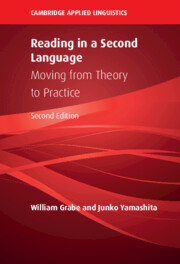Book contents
- Reading in a Second Language
- The Cambridge Applied Linguistics Series
- Reading in a Second Language
- Copyright page
- Dedication
- Contents
- Figures
- Tables
- Preface
- Part I Foundations of Reading
- Part II Patterns of Variation in Reading
- 7 Reading in Different Languages
- 8 L1 and L2 Reading Relationships
- 9 Social Contexts of Reading
- 10 Motivation for Reading
- Part III Developing Reading Comprehension Abilities
- Part IV Expanding Reading Comprehension Skills
- Part V Applications of Reading Research: Instruction and Assessment
- References
- Author Index
- Subject Index
8 - L1 and L2 Reading Relationships
from Part II - Patterns of Variation in Reading
Published online by Cambridge University Press: 01 September 2022
- Reading in a Second Language
- The Cambridge Applied Linguistics Series
- Reading in a Second Language
- Copyright page
- Dedication
- Contents
- Figures
- Tables
- Preface
- Part I Foundations of Reading
- Part II Patterns of Variation in Reading
- 7 Reading in Different Languages
- 8 L1 and L2 Reading Relationships
- 9 Social Contexts of Reading
- 10 Motivation for Reading
- Part III Developing Reading Comprehension Abilities
- Part IV Expanding Reading Comprehension Skills
- Part V Applications of Reading Research: Instruction and Assessment
- References
- Author Index
- Subject Index
Summary
Chapter 8: L1 and L2 Reading Relationships. This chapter explores the various factors influencing L2 reading development, describing various more general L1–L2 differences in reading development, the impact of L1 transfer on L2 reading relative to L2 developmental influences, the role of non-language-specific underlying cognate abilities, and issues of L1-L2 distance and dual language processing. A key conclusion is that L2 reading development emerges out of a combination of L1 transfer and L2 language skills as a dual-language processing system. The chapter first identifies fifteen ways in which L1 reading and L2 reading differ under linguistic differences, cognitive and educational differences, and socio-cultural and institutional differences. Specific relationships between L1 and L2 reading are described in line with four theoretical perspectives: The Interdependence Hypothesis, the Common Underlying Cognitive Processing framework, the Transfer Facilitation Model, and the Language Threshold Hypothesis. The chapter concludes with implications for instruction.
Keywords
- Type
- Chapter
- Information
- Reading in a Second LanguageMoving from Theory to Practice, pp. 168 - 194Publisher: Cambridge University PressPrint publication year: 2022

